In the Footsteps of the Monuments Men: Traces from the Archives at the Metropolitan Museum
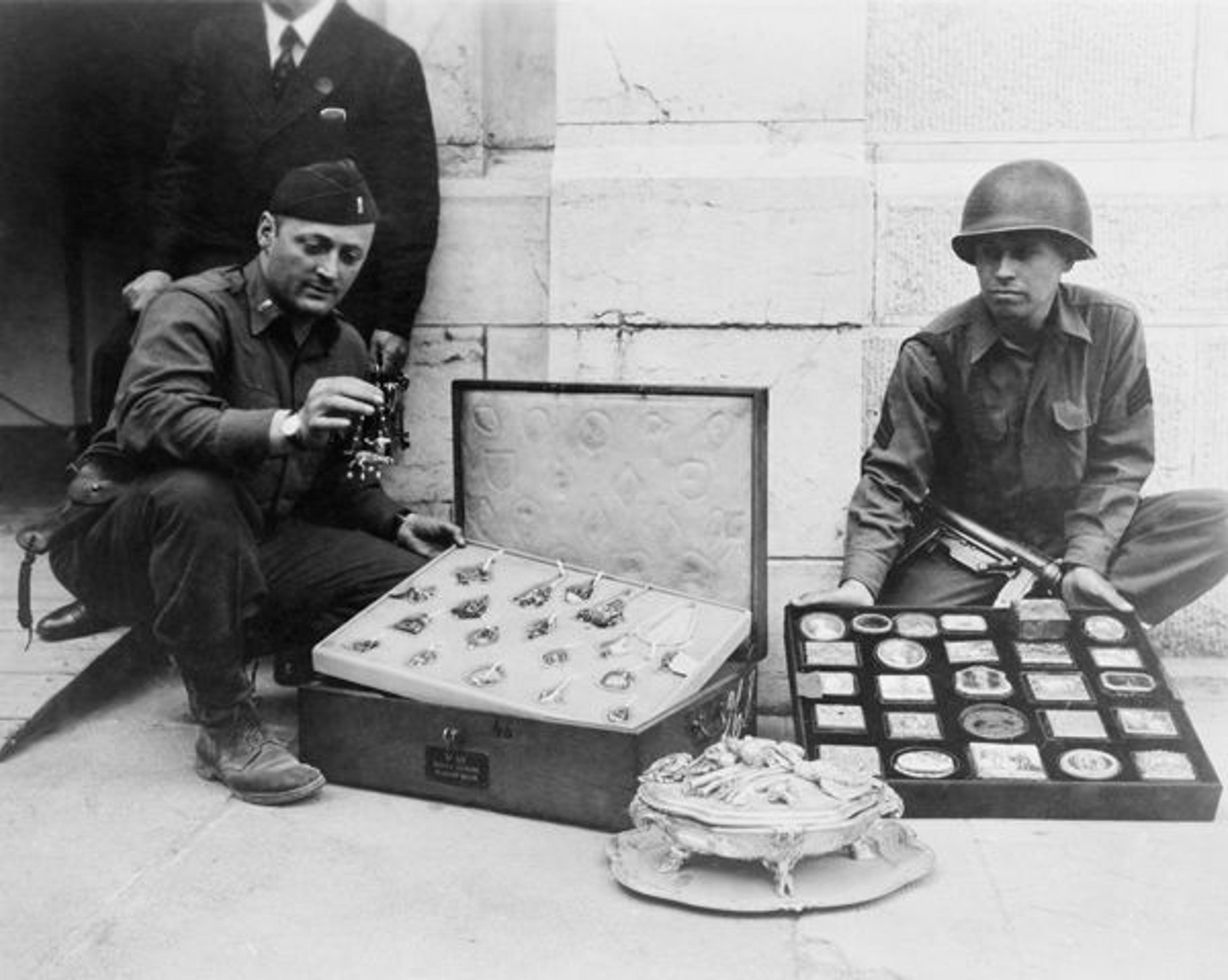
First Lieutenant James J. Rorimer, at left, and Sergeant Antonio T. Valin examine recovered objects. Neuschwanstein, Germany, May 1945. Photograph by U.S. Signal Corps
«During the last years of World War II, Allied forces made a concerted effort to protect artworks, archives, and monuments of historical and cultural significance as they advanced across Europe. They also worked, during the war and after the German surrender, to secure artworks looted by the Nazis and restitute them to their rightful owners. Approximately 345 men and women from thirteen nations were charged with this task; most were volunteers in the Monuments, Fine Art, and Archives program, or MFAA, established in late 1943 under the Civil Affairs and Military Government Sections of the Allied armies. Popularly known as "Monuments Men," their ranks included museum curators, art historians, and others trained to identify and care for artworks subject to harsh conditions.»
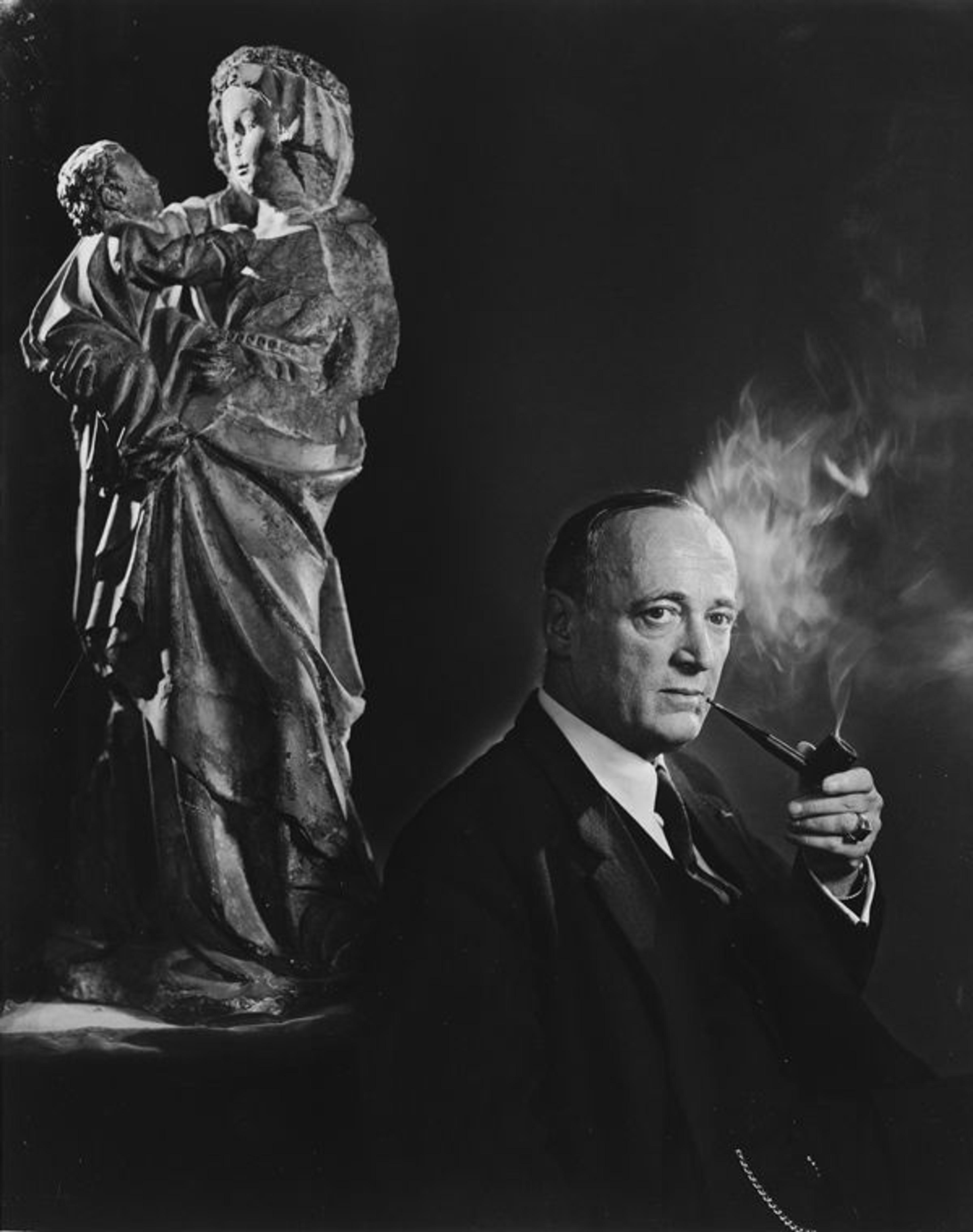
Several of the Monuments Men either were Metropolitan Museum staff members or joined the Museum after the war; they include Theodore Heinrich, Theodore Rousseau, Edith Standen, and Harry D. Grier. Perhaps the most prominent among them was James J. Rorimer, a Harvard-educated medieval art specialist first hired by the Metropolitan in 1927. Rorimer steadily rose through the curatorial ranks and was appointed curator of medieval art in 1934. He played a central role in the development of The Cloisters museum and gardens, the branch of the Museum located in upper Manhattan. In 1943, Rorimer left the Museum to join the United States Army, where he eventually became an officer in the MFAA. Between 1943 and 1946, Rorimer covered a broad territory between northern France and Germany in his pursuit of art treasures confiscated and hidden by the Nazis.
Left: Yousuf Karsh (Canadian [born Armenia], 1908–2002). James Rorimer, 1964. Gelatin silver print. The Metropolitan Museum of Art, New York, Rogers Fund, 1967 (67.543.44). © Yousuf Karsh
Throughout his career, Rorimer carried small pocket notebooks in which he jotted brief memos, reminders, and other work-related information. Among the Museum's archival holdings are several such notebooks; they include references to artworks, historic monuments, and significant people associated with the artwork recovery effort. Mentioned on this page of one of his notebooks is Rose Valland, a staff member of the Jeu de Paume museum in Paris who played a valiant role in the protection and eventual recovery of dozens of works of art by keeping detailed notes on the movement of valuable pieces stolen by Hermann Wilhelm Goering and Joseph Goebbels. Following leads provided by Valland, Rorimer helped uncover a cache of Nazi-looted art at Neuschwanstein Castle in the Bavarian Alps. He and his colleagues later recovered other significant objects looted from museums at the Heilbronn mines in the same area.
During the war, Rorimer wrote letters to his family at home in New York City, providing them with glimpses of his activity as a Monuments Man:
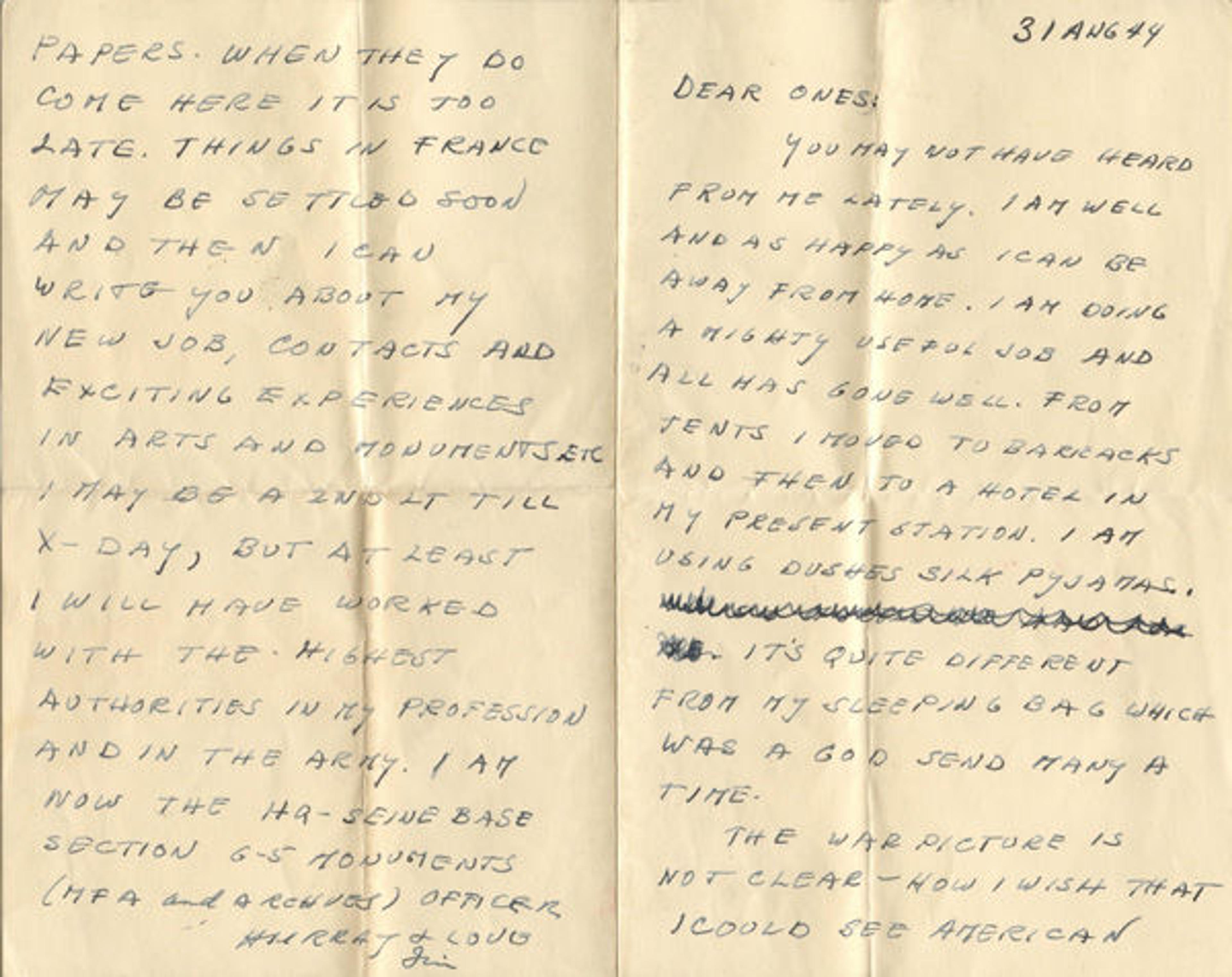
James J. Rorimer to his family, August 31, 1944. Courtesy of Anne Rorimer
After the war, he published a vivid memoir of his wartime service, Survival: The Salvage and Protection of Art in War (Abelard Press, Inc., 1950). A copy is available for reference in Watson Library.
For his service in the MFAA, Rorimer received military decorations including the Bronze Star (1945), European Theatre Ribbon (four battle stars, 1944–1945), and Croix de Guerre (Silver Star, 1945). He was also made a Member of the Legion of Honor (1947) and Officer of the Legion of Honor (1957).

James J. Rorimer receives military decoration, 1945. The Metropolitan Museum of Art Archives
In 1946, Rorimer returned to The Metropolitan Museum of Art, bringing with him a collection of photographs and index cards documenting historic European monuments before and after the war. An exhibition developed from the collection, Medieval Monuments in World War II, was on view at The Cloisters from August 2, 1946, through December 31, 1947. Among the pieces in the exhibition were the following before and after images of the Church of St. Jean in Caen, France. The photographs succinctly capture the war's devastating impact on Europe's monuments and cultural treasures.
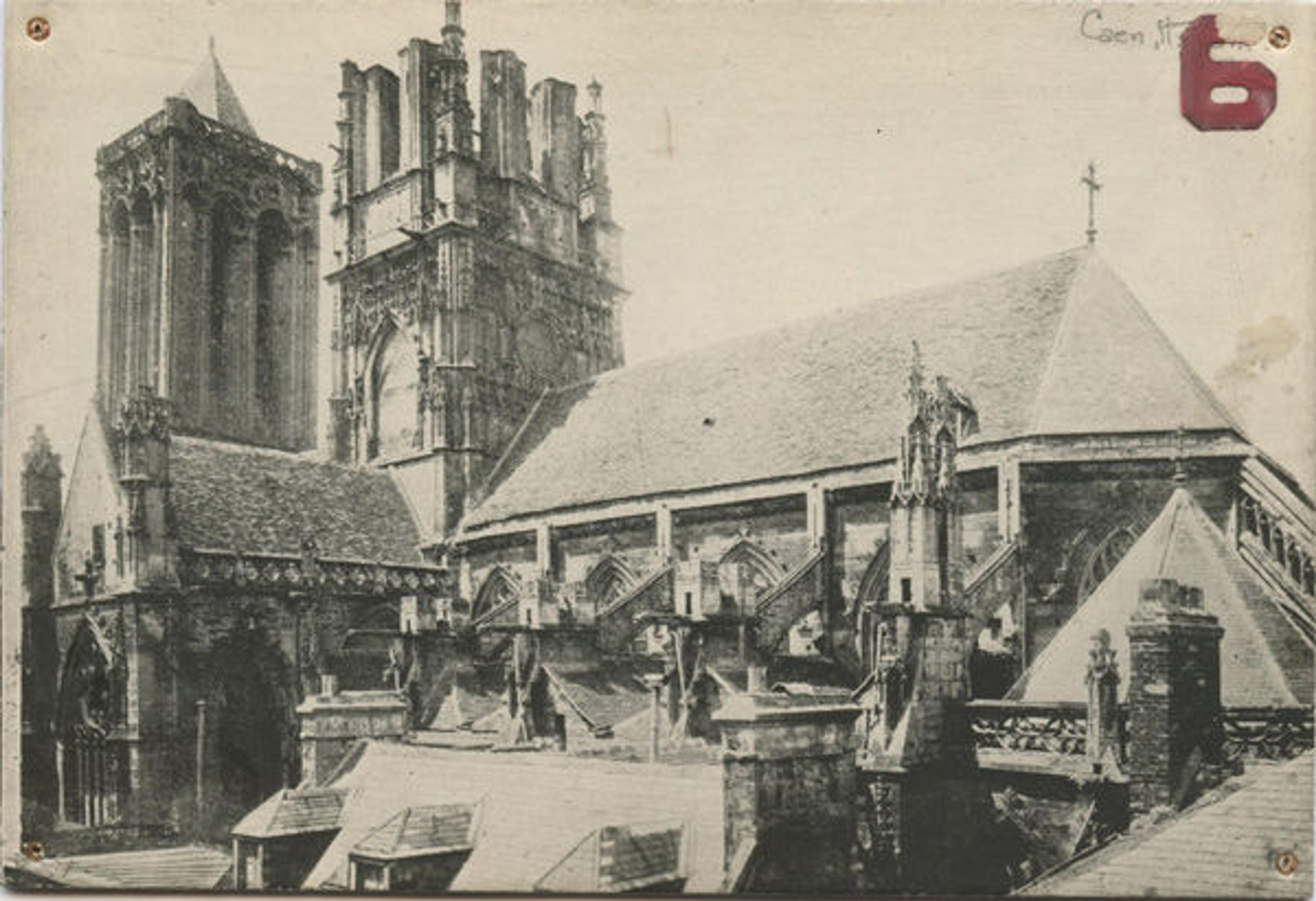

Photographs of Church of St. Jean, Caen, France (before the war, at left, and after the war, at right). Collection 15, Damage of European Monuments During World War II, Box 2, The Cloisters Library and Archives, The Metropolitan Museum of Art
The corresponding index card describes St. Jean before the war as "elegant" and "remarkable for unity of style"; one word, written in red, describes St. Jean after the war: "Destroyed."

Index card for Church of St. Jean, Caen, France, Collection 15, Damage of European Monuments During World War II, Box 2, The Cloisters Library and Archives, The Metropolitan Museum of Art
Between 1946 and 1947, the Metropolitan hosted several other exhibitions that explored the impact of the war on cultural objects and historic monuments. Fine Arts Under Fire (June 14–July 21, 1946) was a special exhibition prepared by LIFE magazine in cooperation with the Roberts Commission (formally known as the American Commission for the Protection and Salvage of Artistic and Historic Monuments in War Areas). The exhibition consisted of thirty photographic panels with accompanying text that showed damage to famous buildings and the MFAA's discoveries of looted art. For more information, seeThe Metropolitan Museum of Art Bulletin, June 1946.
The War's Toll of Italian Art (October 18–November 24, 1946) was organized in collaboration with the American Committee for the Restoration of Italian Monuments. It presented a comprehensive exhibition of photographs, models, and original works illustrating the extensive damage to Italian art during World War II. For more information, see The Metropolitan Museum of Art Bulletin, November 1946.

Paintings Looted from Holland: Returned through the Efforts of The United States Armed Forces (July 1–July 31, 1947) displayed forty-six works by sixteenth- and seventeenth-century Dutch painters on loan from the Dutch government to the United States as a token of gratitude for the MFAA's restoration of Nazi-looted art objects to Holland. The works traveled to a total of thirteen American cities before being returned to Holland. The exhibition catalogue is available for reference in Watson Library.
Right: Exhibition catalogue, Paintings Looted from Holland: Returned through the Efforts of The United States Armed Forces, Office of the Secretary Records, The Metropolitan Museum of Art Archives
On April 2, 1946, General Dwight D. Eisenhower—who had facilitated the MFAA's work by forbidding looting by Allied soldiers and issuing monument protection orders—was elected honorary Fellow for Life of the Museum in recognition of his efforts (see "This Weekend in Met History: April 2"). At the ceremony, Francis Henry Taylor, director of the Metropolitan Museum from 1940 to 1954, stated that the award of honorary Fellow for Life was "in a sense, more than a gesture by the entire academic world to the man, who, more responsible than any other, has made it possible for the world of great civilization in the past to continue for future generations," (New York Times, April 3, 1946). General Eisenhower's address at this event, titled "Art in Peace and War," was printed in The Metropolitan Museum of Art Bulletin, May 1946. Listen to Eisenhower's address.
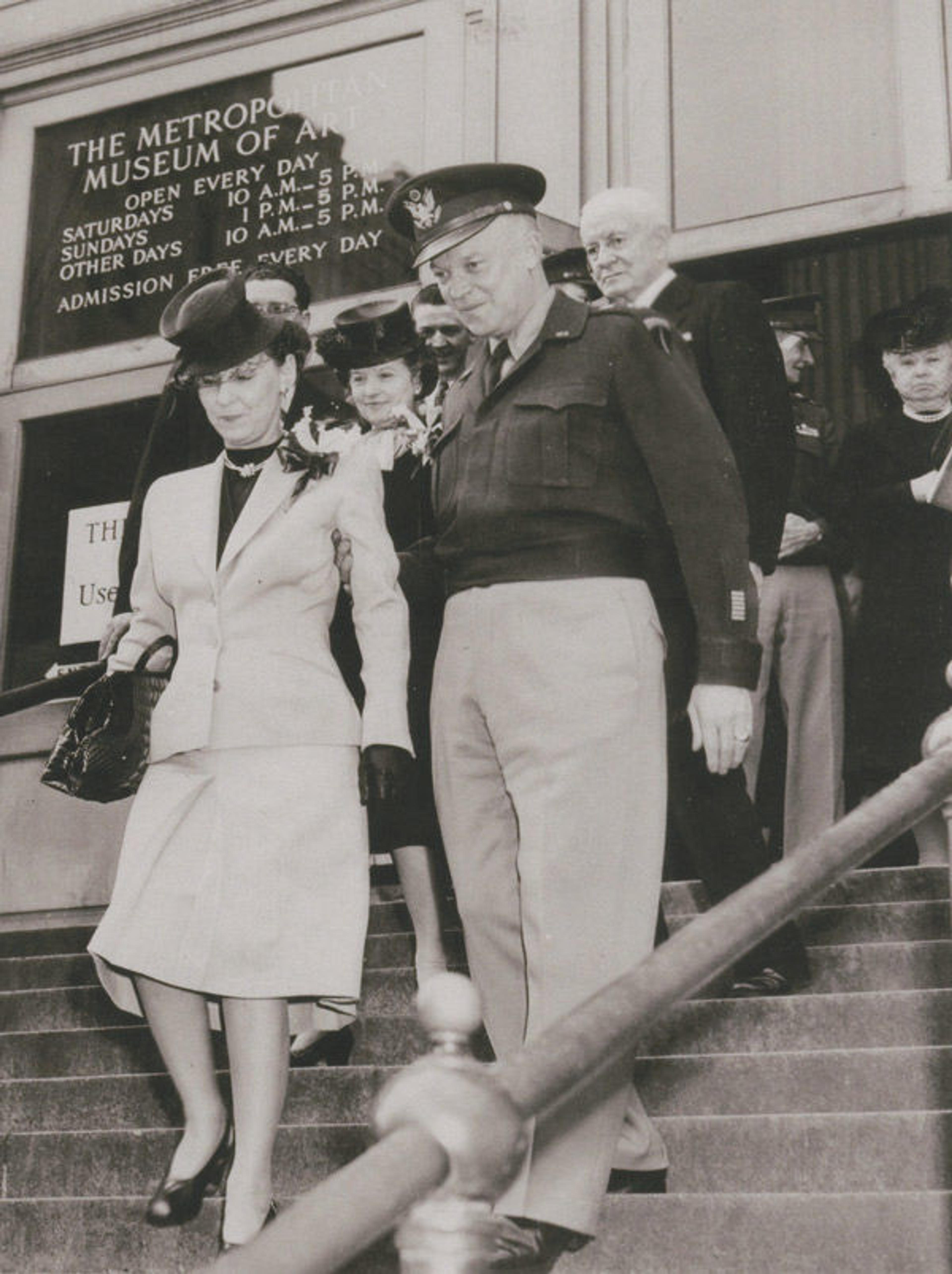
General and Mrs. Eisenhower leaving The Metropolitan Museum of Art, April 2, 1946. Box 8, The Metropolitan Museum of Art 75th Anniversary Committee records, 1945–1950, The Metropolitan Museum of Art Archives. Download the finding aid for these records (PDF).
Hundreds attended the award ceremony, which was broadcast via loudspeaker throughout the Museum. The proceedings were recorded on fragile 78-rpm glass-based 12" lacquer discs that sat silent for decades in the Watson Library and the Museum Archives until 2010, when the Museum received a grant from the Monuments Men Foundation to preserve, digitally remaster, and publish these unique audio recordings online. Eisenhower later served the Museum as Trustee (1948–1953) and Honorary Trustee (1953–1969).
James Rorimer continued his distinguished career at the Metropolitan by serving as director of The Cloisters (1949–1955) and later director of the Museum (1955–1966). As director, he was responsible for many significant acquisitions—including Rembrandt's Aristotle with a Bust of Homer and the Annunciation Triptych (Merode Alterpiece) by the workshop of Robert Campin—oversaw significant expansions of gallery space and visitorship. Rorimer died at age 60 on May 11, 1966.
Related Installation
The Metropolitan Museum of Art Archives celebrates the achievements of the Monuments Men with a special installation of historical photographs, documents, and publications in the Museum's Thomas J. Watson Library from January 31 through March 13, 2014.
Related Links
Museum Itinerary—The Monuments Men at the Met: Treasures Saved During World War II
Now at the Met: "This Weekend in Met History: April 2"
Watson Library Digital Collections: Eisenhower Receives Life Fellowship Award
Page from Rorimer's Notebook

Notebook, 1945, James J. Rorimer Papers, Box 8, The Cloisters Library and Archives, The Metropolitan Museum of Art
Melissa Bowling
Melissa Bowling is the associate archivist in the Museum Archives.
James Moske
James Moske is the managing archivist in the Museum Archives.